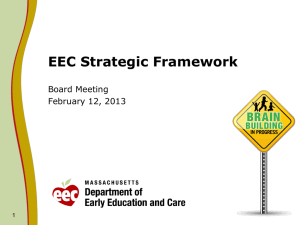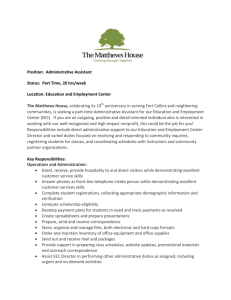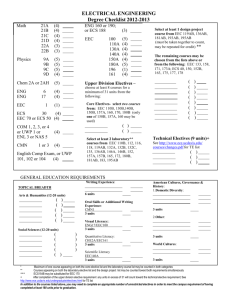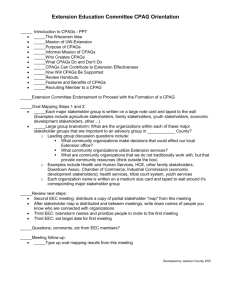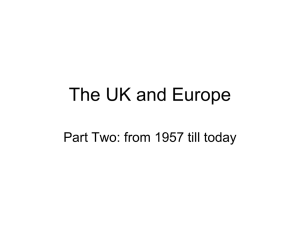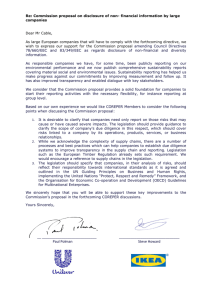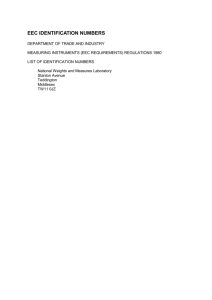Appendix C: EEC Current Architecture and Technology
advertisement
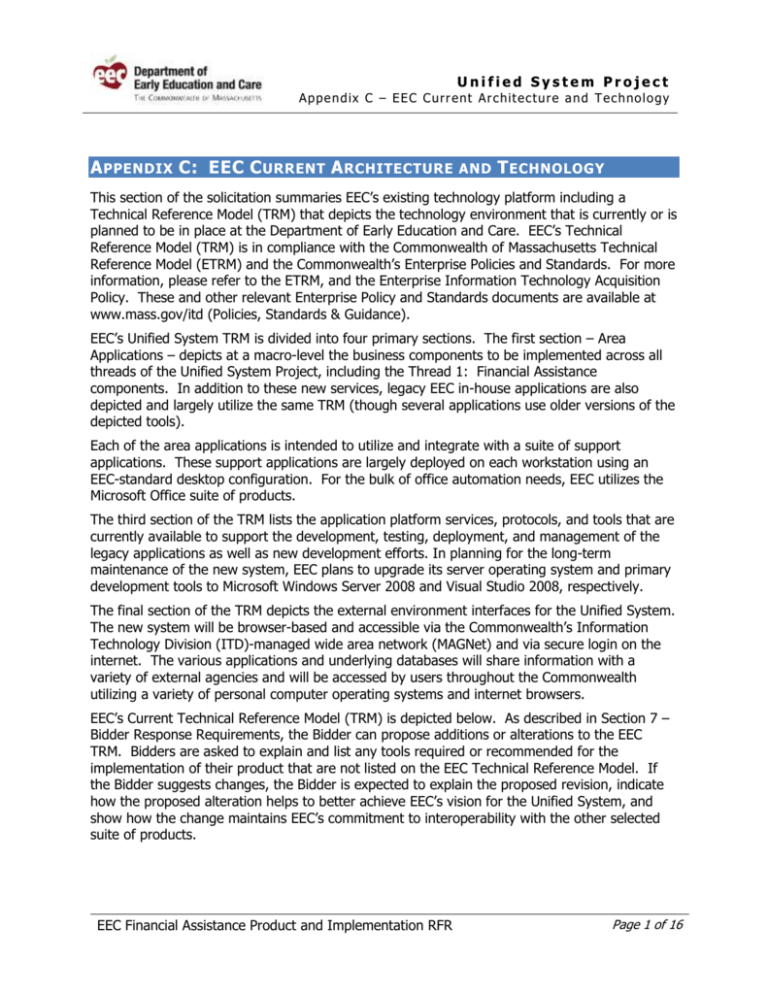
Unified System Project Appe n dix C – E E C C ur r ent Ar c hit ec tu re a n d T ec h no lo gy A PPENDIX C: EEC C URRENT A RCHITECTURE AND T ECHNOLOGY This section of the solicitation summaries EEC’s existing technology platform including a Technical Reference Model (TRM) that depicts the technology environment that is currently or is planned to be in place at the Department of Early Education and Care. EEC’s Technical Reference Model (TRM) is in compliance with the Commonwealth of Massachusetts Technical Reference Model (ETRM) and the Commonwealth’s Enterprise Policies and Standards. For more information, please refer to the ETRM, and the Enterprise Information Technology Acquisition Policy. These and other relevant Enterprise Policy and Standards documents are available at www.mass.gov/itd (Policies, Standards & Guidance). EEC’s Unified System TRM is divided into four primary sections. The first section – Area Applications – depicts at a macro-level the business components to be implemented across all threads of the Unified System Project, including the Thread 1: Financial Assistance components. In addition to these new services, legacy EEC in-house applications are also depicted and largely utilize the same TRM (though several applications use older versions of the depicted tools). Each of the area applications is intended to utilize and integrate with a suite of support applications. These support applications are largely deployed on each workstation using an EEC-standard desktop configuration. For the bulk of office automation needs, EEC utilizes the Microsoft Office suite of products. The third section of the TRM lists the application platform services, protocols, and tools that are currently available to support the development, testing, deployment, and management of the legacy applications as well as new development efforts. In planning for the long-term maintenance of the new system, EEC plans to upgrade its server operating system and primary development tools to Microsoft Windows Server 2008 and Visual Studio 2008, respectively. The final section of the TRM depicts the external environment interfaces for the Unified System. The new system will be browser-based and accessible via the Commonwealth’s Information Technology Division (ITD)-managed wide area network (MAGNet) and via secure login on the internet. The various applications and underlying databases will share information with a variety of external agencies and will be accessed by users throughout the Commonwealth utilizing a variety of personal computer operating systems and internet browsers. EEC’s Current Technical Reference Model (TRM) is depicted below. As described in Section 7 – Bidder Response Requirements, the Bidder can propose additions or alterations to the EEC TRM. Bidders are asked to explain and list any tools required or recommended for the implementation of their product that are not listed on the EEC Technical Reference Model. If the Bidder suggests changes, the Bidder is expected to explain the proposed revision, indicate how the proposed alteration helps to better achieve EEC’s vision for the Unified System, and show how the change maintains EEC’s commitment to interoperability with the other selected suite of products. EEC Financial Assistance Product and Implementation RFR Page 1 of 16 Unified System Project Appe n dix C – E E C C ur r ent Ar c hit ec tu re a n d T ec h no lo gy EEC Financial Assistance Product and Implementation RFR Page 2 of 16 Unified System Project Appe n dix C – E E C C ur r ent Ar c hit ec tu re a n d T ec h no lo gy A REA A PPLICATIONS EEC U NIFIED S YSTEM B USINESS C OMPONENTS These area applications (or business components) are applications and groupings of services that support the current and planned business operations of EEC. Detailed background information on the vision, scope, and requirements for each of these business components is provided in the “Detailed Requirements Document” attached as Appendix D. The specific financial assistance related functionality being requested as part of this solicitation can be found in the Product Functionality Matrix included as Appendix A of this solicitation. L EGACY EEC I N -H OUSE A PPLICATIONS Included in this section of the RFR is a listing of the legacy applications currently in production at EEC. EEC expects that at least three of these applications (CCIMS, eCCIMS, and Contracts/Vendor Query) will be completely replaced by Thread 1: Financial Assistance of the Unified System Project. The selected Vendor will be responsible for coordinating with the EEC IT Department who will manage the rollout of new functionality, the conversion of existing data, and the transition of user access from the legacy systems to the new Unified System. Each of the legacy systems is described below, including the year initially deployed, the application environment, the underlying database, and the application architecture. The diagram below depicts the migration of access, functionality, and information from the various EEC legacy applications to the envisioned Unified System business components and related services, including the systems to be replaced during Thread 1: Financial Assistance of the Unified System Project which are highlighted in yellow. All applications and databases reside at EEC offices and the successful Vendor will have access to these data sources and corresponding source code. EEC Financial Assistance Product and Implementation RFR Page 3 of 16 Unified System Project Appe n dix C – E E C C ur r ent Ar c hit ec tu re a n d T ec h no lo gy Migration from EEC Legacy Applications to the Unified System Business Components Data Warehouse/Dashboard Reporting Legacy EEC In-House Applications EEC Web Site CORI/ Background Checks Contracts/ Vendor Query Licensing Grants* EECRS (Tracking System) Waiting List System CCIMS QRIS Program Manager eCCIMS Professional Certifications & Scholarships Professional Qualifications Registry Migrate to browser-based application, expand access and functionality, design based on SOA, and convert to enterprise data architecture Licensing, Monitoring, and Support Purchase of Services Child Family Access and Assistance Professional Development EEC Unified IT System Business Components * Desirable but not critical to be addressed as part of Thread 1: Financial Assistance migration. Additional detailed information about many of these applications, including the applications to be replaced in Thread 1: Financial Assistance, is included in Appendix E – “Legacy System Documentation.” EEC Financial Assistance Product and Implementation RFR Page 4 of 16 Unified System Project Appe n dix C – E E C C ur r ent Ar c hit ec tu re a n d T ec h no lo gy CCIMS CCIMS is a distributed system used by contracted Child Care Resource and Referral Agencies (CCRRs) to determine eligibility, perform intake, track attendance, and process billing for voucher-based child care subsidies for approximately 29,000 children placed monthly with 4,900 providers throughout the Commonwealth. Year Deployed: Application Environment: Database: Application Architecture: 2001 Visual Basic 6.0 MS SQL Server 2005 Distributed, client server C ONTRACTS /V ENDOR Q UERY The Contracts/Vendor Query application manages contract issuance, amendments, and renewals for contracts issued by EEC. Users can generate contract documents using the application. The current Contracts application and database are not directly tied into the Massachusetts Management, Accounting, and Reporting System (MMARS). Year Deployed: Application Environment: Database: Application Architecture: 2001 Visual Basic 6.0 MS SQL Server 2005 Client server CORI/B ACKGROUND R ECORD C HECKS (BRC) The CORI/Background Check application manages the intake, processing, and result notifications for child care workers and others with direct, unsupervised contact with children in the Commonwealth. EEC conducts criminal background checks in coordination with the Criminal History Systems Board (CHSB) and child abuse and neglect background checks in coordination with the Department of Children and Families (DCF). In 2008, EEC conducted nearly 100,000 background checks. Also in 2008, EEC released the BRC Manager to provide secure, online notifications of BRC results, and in 2009, implemented an XML-based web services exchange with DCF for the matching of BRC requests against supported DCF records. Year Deployed: Application Environment: Database: Application Architecture: 1998 Visual Basic 6.0 MS SQL Server 2005 Client server D ATA W AREHOUSE /D ASHBOARD R EPORTING The EEC Data Warehouse is a prototype application based on Microsoft SQL Server 2005 Analysis Services. This warehouse contains information from a variety of EEC’s legacy databases. New standardized reports are continuously being developed utilizing the underlying information in the data warehouse. The data warehouse will continue to be maintained by the EEC IT Operations Group. EEC Financial Assistance Product and Implementation RFR Page 5 of 16 Unified System Project Appe n dix C – E E C C ur r ent Ar c hit ec tu re a n d T ec h no lo gy Year Deployed: Application Environment: Database: Application Architecture: 2007 MS SQL Server 2008 Analysis Services MS SQL Server 2008 Data warehouse EEC W EB S ITE EEC’s web site is a large public-facing website hosting information pertaining to families, providers, educators, and the general public. The EEC web site is accessible at www.eec.ma.state.us and utilizes the standards promulgated by Mass.gov. The web site was recently portalization by ITD as part of Mass.gov. Year Deployed: Application Environment: Database: Application Architecture: 2000/2005 current MS .Net Framework MS SQL Server 2005 Internet/web E CCIMS eCCIMS is an online, browser-based system utilized by 250 child care providers to track eligibility, intake, attendance, and billing for contracted child care. Contracted services are provided to approximately 18,000 children. Data from EEC’s Licensing and Contracts databases replicate to eCCIMS nightly. eCCIMS permits online submission of billing, but there is no connection to Commonwealth’s MMARS system. Year Deployed: Application Environment: Database: Application Architecture: 2005 ASP and MS .Net Framework MS SQL Server 2005 Internet/web EECRS ( FORMERLY T RACKING S YSTEM ) The EECRS (formerly known as the Tracking System) tracks information about self-reported incidents and third-party complaints alleging regulatory malfeasance on the part of licensed child care providers. The system records the allegations, tracks regulation violations, and includes templates for reporting. The Tracking database is integrated with EEC’s Licensing database. Year Deployed: Application Environment: Database: Application Architecture: 2002 Visual Basic 6.0 MS SQL Server 2005 Client server G RANTS D ATA S OURCES EEC administers multiple grants to improve early education and care and to meet the unique needs of young children. The Grants database and Grants Management Spreadsheet are used EEC Financial Assistance Product and Implementation RFR Page 6 of 16 Unified System Project Appe n dix C – E E C C ur r ent Ar c hit ec tu re a n d T ec h no lo gy to manage grant budgets and spending. They also aids in the submission of required documentation. Current grant programs include Community Partnerships for Children, Early Childhood Special Education, Massachusetts Family Network, Head Start Supplemental Grant, Parent-Child Home Program, and Universal Pre-Kindergarten Classroom Quality and Assessment Planning. Year Deployed: Application Environment: Database: Application Architecture: 2004 MS Access, MS Excel MS SQL Server 2005 1-tier L ICENSING The Licensing application and database store information about all licensed child care providers in the state. Licensors, regional staff, and other EEC users record applications for licensure, collect licensing fees (about one million dollars annually), issue licenses, and maintain the status of licenses (e.g., moves, closings, freezes) using this application. The application also tracks interactions with and visits to programs and other licensing transactions. The Licensing application also includes a reminder system to help licensors track upcoming due dates, next steps, and other activities associated with the complaint and licensing processes and licensor caseloads. In 2010 the Licensing application, which has been in production since 2003, was ported from a client server to a web based environment. Year Deployed: Application Environment: Database: Application Architecture: 2010 MS .Net Framework 3.5 MS SQL Server 2005 Internet/web P ROFESSIONAL C ERTIFICATIONS AND S CHOLARSHIPS The Professional Certifications (formerly known as the Teacher Qualifications or TQ system) is a browser-based application accessed via EEC’s public web site. Applicants can use the online system to enter and submit applications for EEC certification as teachers, lead teachers, or directors under EEC’s group child care regulations. Applicants can also review the status of their applications online. A related smaller application manages scholarships originating from the Department of Higher Education. Year Deployed: Application Environment: Database: Application Architecture: 2006 MS .Net 1.1 Framework, VB.Net MS SQL Server 2005 Internet/web EEC Financial Assistance Product and Implementation RFR Page 7 of 16 Unified System Project Appe n dix C – E E C C ur r ent Ar c hit ec tu re a n d T ec h no lo gy P ROFESSIONAL Q UALIFICATIONS R EGISTRY The Professional Qualifications Registry is a browser-based application accessed via EEC’s public web site. The Registry is master repository of all early education and out of school time educators, including those who are working programs that are and are not subject to EEC licensure. It provides educators with a common place to track their qualifications and professional development over time. The Registry shares information with the Professional Certifications system. However, the Registry has a much broader population of records than the Professional Certification system which includes only those educators who have applied for an EEC Certification. Year Deployed: Application Environment: Database: Application Architecture: 2010 MS .Net 3.5 Framework, MS SQL Server 2005 Internet/web Q UALITY R ATING AND I MPROVEMENT S YSTEM (QRIS) P ROGRAM M ANAGER A Quality Rating and Improvement System (QRIS) is a method to assess, improve, and communicate the level of quality in early education and care and after-school settings. QRIS are similar to other consumer rating systems in that they "rate" goods or services to provide customers with a better understanding about the quality of that item. EEC’s QRIS Program Manager supports the submission and evaluation of program applications for QRIS ratings. Year Deployed: Application Environment: Database: Application Architecture: 2010 MS .Net 3.5 Framework MS SQL Server 2005 Internet/web W AITLIST M ANAGEMENT S YSTEM ( IN P ROCESS ) EEC offers financial assistance to help eligible low-income working and at risk families pay for early education and care and out-of-school time programs. EEC is legislatively mandated to maintain a consolidated waiting list for all subsidized early education and care programs and services in the Commonwealth. EEC is in the process of customizing a centralized Waiting List solution (KinderWait) to improve data collection and manage subsidized care administration. Year Deployed: Application Environment: Database: Application Architecture: 2011 (planned) MS .Net 3.5 Framework MS SQL Server 2008 Internet/web EEC Financial Assistance Product and Implementation RFR Page 8 of 16 Unified System Project Appe n dix C – E E C C ur r ent Ar c hit ec tu re a n d T ec h no lo gy S UPPORT A PPLICATIONS Support applications are used by EEC staff on a daily basis to perform activities that may or may not be associated with the specified area applications. These support applications tend to use a common implementation across workstations and include the applications generally considered office desktop applications. Currently, EEC workstations and laptops utilize a standardized configuration of Microsoft Office 2007. Category Support Application (comments) Email Microsoft Outlook 2007 Microsoft Exchange Server (managed by the Information Technology Division of the Commonwealth) Collaboration Microsoft SharePoint 2007 Microsoft Project 2003/07 (migration to 2007 planned during life of Unified System Project) Spreadsheet Microsoft Excel 2007 Data Analysis Microsoft Access 2007 SQLServer Report Builder (EEC is currently looking to expand use of this tool) Word Processing Microsoft Word 2007 Reporting Microsoft SQL Server 2008 Reporting Services (upgraded RS in coordination with DBMS upgrade) OLAP Cubes (as a component of the EEC data warehouse) Antivirus Symantec Antivirus 10.1.8 (versions updated as necessary) A PPLICATION P LATFORM S ERVICES , P ROTOCOLS , AND T OOLS EEC utilizes the following suite of services, protocols, and tools to develop and support its existing applications. Depending on the fit with the technology infrastructure of the proposed product, these may be utilized in developing and implementing Thread 1: Financial Assistance of Unified System. Vendors should take these into consideration as part of their bids. EEC Financial Assistance Product and Implementation RFR Page 9 of 16 Unified System Project Appe n dix C – E E C C ur r ent Ar c hit ec tu re a n d T ec h no lo gy Additional services, protocols, and tools may be considered as appropriate for the Unified System Project. S ERVICES The elements included in this part of the TRM provide the environment for applications to be developed, to interact with other applications, and to utilize the computing platform. Most of these elements are third-party packages. Where available, the planned version number has been included. Other elements may be in-house developed or open source tools. Several of the services listed below are common services that are fundamental services intended to be used across area applications. These include security, data management, systems management, or other key application services. Below is a listing of the current primary services that the responding Vendors should take into consideration as part of their bids. Additional or alternate services may be considered, as appropriate, for the Unified System Project. Category Services (comments) Virtual Server Management VMware ESX Server (currently being procured for legacy server Network Operating System Microsoft Windows Server 2008 OS (EEC plans to upgrade its server Data Management Microsoft SQL Server 2005/08 (EEC plans to upgrade its DBMS from Language Microsoft .Net Framework 3.5 (EEC utilizes various versions of replacement) OS from 2003 to 2008 for the Unified System Project) SQL Server 2005 to 2008 for the Unified System Project; other legacy applications may continue to use older versions of MS SQL Server) Microsoft Component Object Model in current implementations) Visual Studio 2008 (prior EEC applications have use Visual Basic 6.0) Team Foundation Server (planned to be used for team project management including version control) Web Server Microsoft IIS 7.0 (EEC currently uses IIS 6.0 as its web server) Application Server Microsoft Windows Server 2008 (EEC plans to migrate from Windows Messaging/Web Services Microsoft Message Queuing 4.0 Server 2003 to 2008 for the Unified System Project) Windows Communication Foundation (WCF) EEC Financial Assistance Product and Implementation RFR Page 10 of 16 Unified System Project Appe n dix C – E E C C ur r ent Ar c hit ec tu re a n d T ec h no lo gy XML-based web services (WS) User Authentication EEC Single Sign-on (EEC SSO was implemented in February 2008 to provide a single source for user authentication across all EEC browser accessible applications. Vendors will need to access whether the EEC Single Sign-on is sufficient to meet the needs of the Unified System. Vendors may recommend other solutions for user authentication.) P ROTOCOLS Below is a listing of the primary protocols that the responding Vendors should take into consideration as part of their bids. Additional protocols may be considered, as appropriate, for the Unified System Project. Category Protocols (comments) Database Protocols ADO.Net (most prominent protocol used by EEC) Open Database Connectivity (ODBC) Java Database Connectivity (JDBC) Object Linking and Embedding, Database (OLE-DB) Security Protocols Secure Sockets Layer (SSL) Transport Layer Security (TLS) Messaging Protocols Extensible Markup Language (XML) Simple Object Access Protocol (SOAP) Transport Protocols Hypertext Transfer Protocol (HTTP) Hypertext Transfer Protocol over Secure Socket (HTTPS) Simple Mail Transfer Protocol (SMTP) File Transfer Protocol (FTP) Transmission Control Protocol (TCP) T OOLS The final grouping in this area of the TRM is tools. Several of the tools listed below may apply chiefly to the hardware environment on which the area applications will reside. Vendors may propose suggested tools in addition to the ones listed below, in particular for categories listed EEC Financial Assistance Product and Implementation RFR Page 11 of 16 Unified System Project Appe n dix C – E E C C ur r ent Ar c hit ec tu re a n d T ec h no lo gy as “TBD.” Category Tools (comments) User Interface Authoring Visual Studio 2008 (EEC currently uses Visual Basic 6.0 for many legacy applications) Version control using Visual SourceSafe or TFS iRise (EEC has licenses for iRise as a simulation and prototyping user interface tool. This tool does not generate code but may be used in application design to quickly solicit user feedback.) Load Balancing VMware ESX Server Tape/Backup Management Symantec Backup Exec 10/12 (EEC expects to upgrade to version 12 for the Unified System Project) Ultrium LTO Fault and Recovery VMware ESX Server HP Insight Manager Performance and Capacity Visual Studio Team System Test Edition (EEC is considering adopting this product for wider use) Forms and Reports Adobe Portable Document Format (PDF) HyperText Markup Language (HTML) Microsoft SQL Server 2008 Reporting Services (EEC plans to upgrade its reporting services in coordination with its DBMS) User Documentation TBD (EEC is considering Adobe RoboHelp 7 and currently uses Requirements Tracking TBD (EEC is considering use of MS SharePoint and Team Foundation Automated Testing TBD (EEC is considering Visual Studio Team System Test Edition as Incident Tracking TBD (EEC currently uses BugTracker for incident tracking and BrainShark for audio/visual instructions) Serve for project and team management including requirements tracking) an automated testing tool) application changes and is planning on using Team Foundation Server going forward) EEC Financial Assistance Product and Implementation RFR Page 12 of 16 Unified System Project Appe n dix C – E E C C ur r ent Ar c hit ec tu re a n d T ec h no lo gy Accessibility Testing Firefox Accessibility Extension N ETWORKING , I NFORMATION E XCHANGE , AND U SERS The final area of the Technical Reference Model depicts the external interactions for the area applications, including how applications are accessed and by whom. Details about planned information exchanges are included in the Appendix A – “Product Functionality Matrix” and Appendix D – “Detailed Requirements Document.” EEC’s web-based applications are accessed via the Massachusetts Access to Government Network (MAGNet) developed and maintained by the Information Technology Division of the Commonwealth. The system must comply with all Information Technology Division’s Enterprise and MAGNet’s architecture, policies, and standards. In particular, the Vendor must abide by the specifications in the following libraries of standards in the Commonwealth’s Enterprise Technical Reference Model (ETRM) and the Information Technology Architecture and Enterprise Standards. EEC is responsible for maintaining its local area network, on which the Unified System will be developed and deployed for internal users. Category Networking Element (comments) Internet Access MAGNet (managed and maintained by Commonwealth’s Information Firewall/WAN MAGNet (managed and maintained by Commonwealth’s Information LAN Management HP Insight Manager Technology Division) Technology Division) Microsoft Windows Server Update Services (manages software distribution) Based on the requirements for the planned Unified System, EEC expects data exchanges with the following Commonwealth entities as part of the scope of this solicitation for Thread 1: Financial Assistance. The table below summarizes the nature of the planned exchanges with these agencies. Please see the Detailed Requirements Document for a comprehensive list of all required exchanges across all threads and the details of each exchange. Sending/Receiving Agency Department of Children and Families (DCF) Nature of Exchange Provide child, family and authorization/termination information for all families referred by DCF to EEC Access status of children in care EEC Financial Assistance Product and Implementation RFR Page 13 of 16 Unified System Project Appe n dix C – E E C C ur r ent Ar c hit ec tu re a n d T ec h no lo gy Department of Elementary and Secondary Education (ESE) Obtain SASID and child information Share information on comprehensive and longitudinal development profile for the child Department of Transitional Assistance (DTA) Provide child, family and authorization/termination information for all families referred by DTA to EEC Access status of children in care OCS MMARS Manage vendors and contracts Manage encumbrances Manage payments Manage receivables Track accounts EEC internal users include the staff of the Department located at the EEC Central Office and at five EEC regional offices. There are approximately 180 internal users of EEC applications. To a large extent, these users currently access the EEC user applications using standardized workstation configurations of Microsoft XP Professional and IE 8.0. Category Internal Users Elements (comments) Operating System Microsoft XP Professional (EEC may upgrade its workstation OS to MS Browser Microsoft Internet Explorer 8.0 (EEC may to upgrade its workstation Windows 7.0 or other Microsoft OS over the life of the Unified System Project) standard web browser from IE 8.0 to a higher version over the life of the Unified System Project) EEC’s web applications will be accessed by approximately 20,000 to 30,000 users throughout the Commonwealth. Of this total, approximately 1,000 to 2,000 users will access EEC applications from partner agencies (e.g., child care resource and referral agencies) at a moderate level of usage. The remainder of the external users will access EEC applications relatively infrequently. These users utilize a variety of different Intel and Mac based computers and various operating systems and browsers. Category External Users Elements (comments) Operating System Windows XP EEC Financial Assistance Product and Implementation RFR Page 14 of 16 Unified System Project Appe n dix C – E E C C ur r ent Ar c hit ec tu re a n d T ec h no lo gy Windows Vista Windows 7 Max OS X 10.4+ (external users may access EEC area applications using a variety of different operating systems, including Windows-based or Mac-based systems) Browser Microsoft Internet Explorer 6.0+ Mozilla Firefox 2.0+ Safari 3.0+ Google Chrome (external users may access EEC area applications using any of the specified supported browsers) P LANNED H ARDWARE AND N ETWORK Below is a diagram of the planned environments for the Unified System. EEC plans on utilizing a mix of dedicated HP Proliant DL380 G5 dedicated servers and virtual machines. Dedicated servers have been planned for the production application server and the production database server. Virtual machines are planned for the web server, the development environments, and the test environments. All access via the internet will be via the Commonwealth’s MAGNet network, managed by the Information Technology Division. Additional hardware will likely be purchased for the project as the Unified System is being developed. In addition to those servers listed, EEC will provide the successful Bidder with additional details concerning its existing and planned servers and network topography. EEC Financial Assistance Product and Implementation RFR Page 15 of 16 Unified System Project Appe n dix C – E E C C ur r ent Ar c hit ec tu re a n d T ec h no lo gy EEC Offices External Users Metro Boston (T1, Hub linked to 25+ PCs) External Access ITD EEC DMZ (51 Sleeper St) Southeast Mass (T1, Switch to 25+ PCs) Production Web Server (VM) HP Proliant DL380 G5 4x 36 GB HD 2x Quad Core 3.16 GHz 32 GB RAM Quad Port NIC Vmware ESX MS Server 2008 MS IIS 7.0 ITD Firewall for 51 Sleeper St Northeast Mass (T1, Switch to 25+ PCs) Switch for Subnet MAGNet Central Mass (T1, Switch to 25+ PCs) Western Mass (T1, Switch to 25+ PCs) Production Database Server HP Proliant DL380 G5 6x 72 GB HD 2x Quad Core 3.16 GHz 4 GB RAM Duel Port NIC MS Server 2008 MS SQL Server 2008 Production Application Server HP Proliant DL380 G5 6x 72 GB HD 2x Quad Core 3.16 GHz 4 GB RAM Duel Port NIC MS Server 2008 Development Application Server (VM) HP Proliant DL380 G5 4x 36 GB HD 2x Quad Core 3.16 GHz Development Database Server (VM) Test Application Server (VM) 32 GB RAM HP Proliant DL380 G5 HP Proliant DL380 G5 Quad Port NIC 4x 36 GB HD 4x 36 GB HD Vmware ESX 2x Quad Core 3.16 GHz 2x Quad Core 3.16 GHz MS Server 2008 32 GB RAM 32 GB RAM Quad Port NIC Quad Port NIC Vmware ESX Vmware ESX MS Server 2008 MS Server 2008 MS SQL Server 2008 EEC Financial Assistance Product and Implementation RFR Central Office (Switch to 90+ PCs) Test Database Server (VM) HP Proliant DL380 G5 4x 36 GB HD 2x Quad Core 3.16 GHz 32 GB RAM Quad Port NIC Vmware ESX MS Server 2008 MS SQL Server 2008 Page 16 of 16
